The document provides an overview of functional programming in C++, highlighting its principles such as first-class functions, higher-order functions, and immutability. It discusses how functional programming can enhance code quality and offers comparisons between functional concepts in C++ and other languages like Haskell and Python. Key features such as lambda functions, recursion, and list processing are explained along with their implementation in C++.

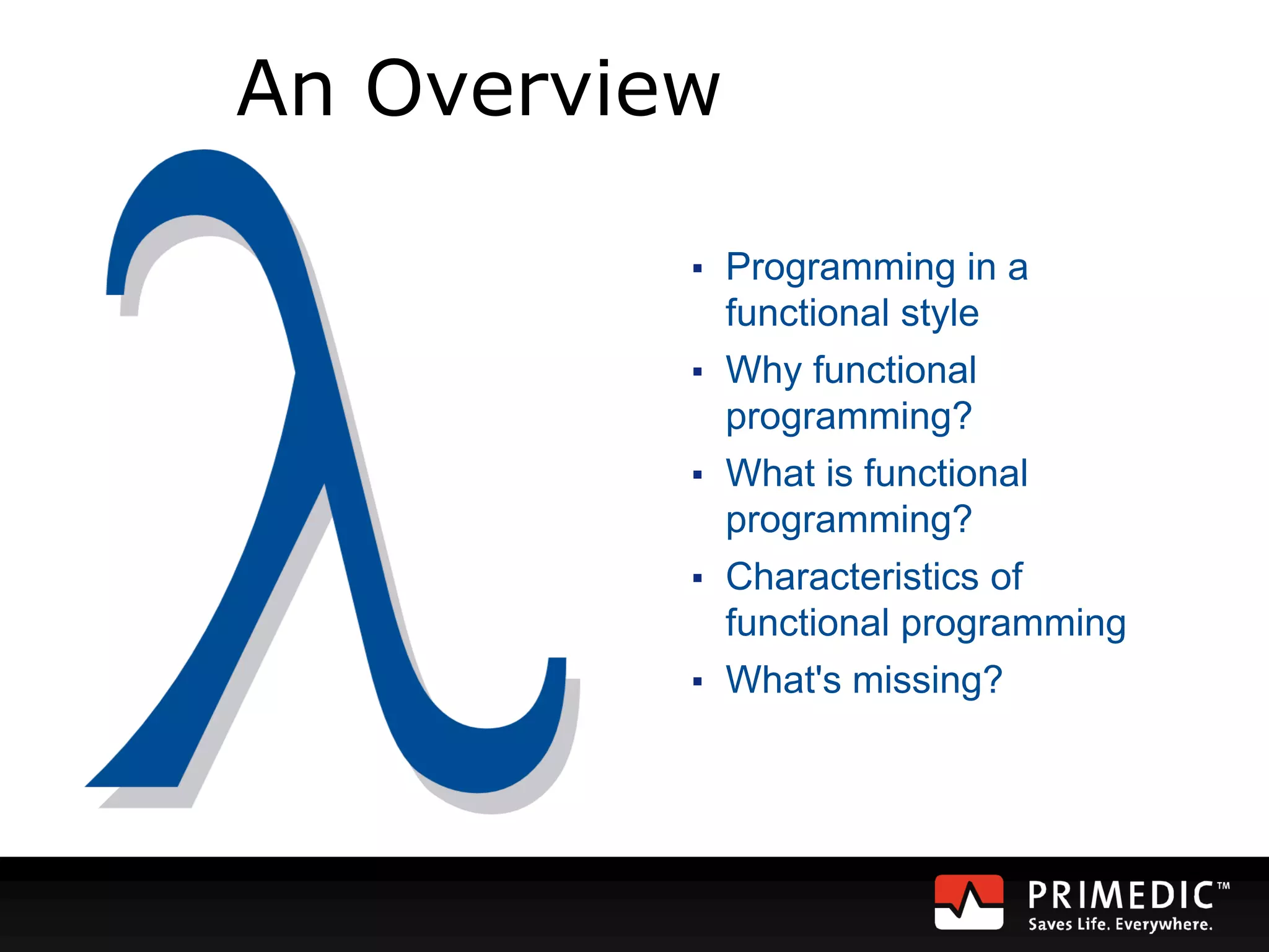
![Functional in C++
▪ Automatic type deduction
for ( auto v: myVec ) std::cout << v << " ";
▪ Lambda-functions
int a= 2000, b= 11;
auto sum= std::async( [=]{return a+b;});
▪ Partial function application
std::function and std::bind
lambda-functions and auto
Haskell Curry Moses Schönfinkel](https://image.slidesharecdn.com/functionalprogramminginc-141117051806-conversion-gate01/75/Rainer-Grimm-Functional-Programming-in-C-11-3-2048.jpg)
![Functional in C++
▪ Higher-order functions
std::vec<int> vec{1,2,3,4,5,6,7,8,9};
std::for_each(vec.begin(),vec.end(), [ ] (int& v) { v+= 10 });
std::for_each( vec.begin(),vec.end(),
[ ] (int v){ cout << " " << v } );
11 12 13 14 15 16 17 18 19
▪ Generic Programming (Templates)
▪ Standard Template Library
▪ Template Metaprogramming
Alexander Stepanov](https://image.slidesharecdn.com/functionalprogramminginc-141117051806-conversion-gate01/75/Rainer-Grimm-Functional-Programming-in-C-11-4-2048.jpg)
{return a+b;});
▪ Recognizing functional patterns
template <int N>
struct Fac{ static int const val= N * Fac<N-1>::val; };
template <>
struct Fac<0>{ static int const val= 1; };
▪ Better programming style
▪ reasoning about side effects
▪ more concise](https://image.slidesharecdn.com/functionalprogramminginc-141117051806-conversion-gate01/75/Rainer-Grimm-Functional-Programming-in-C-11-5-2048.jpg)
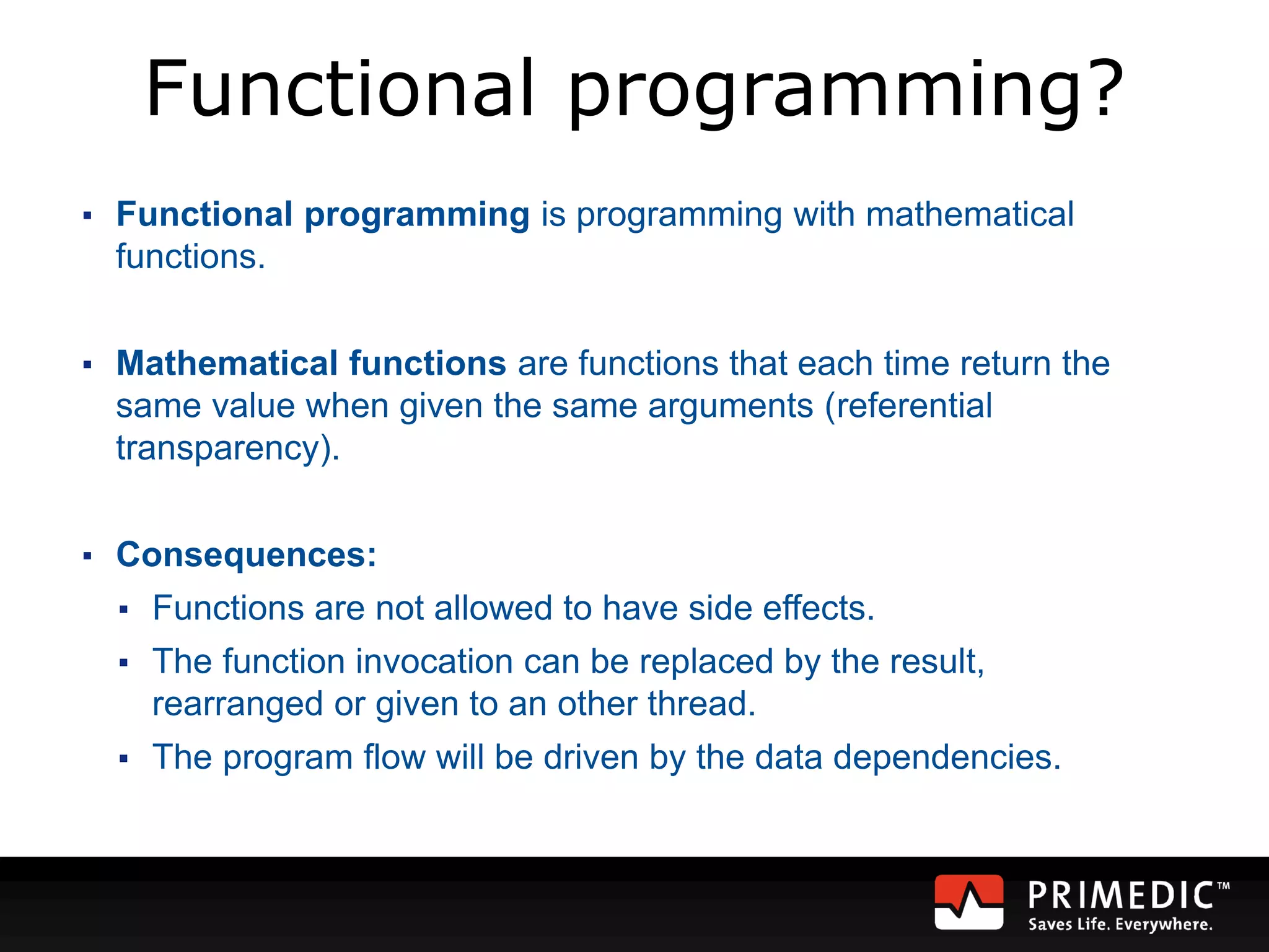
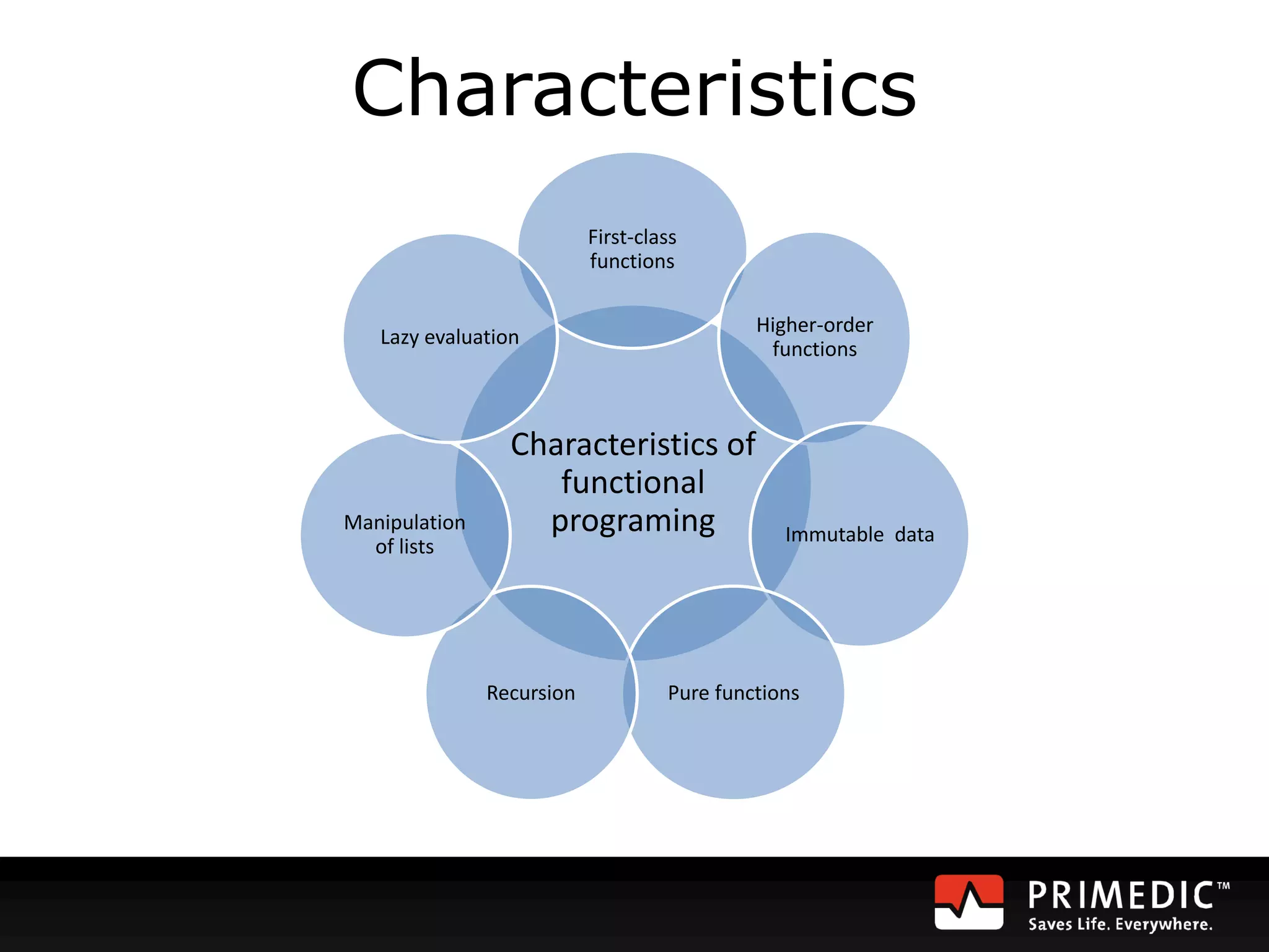
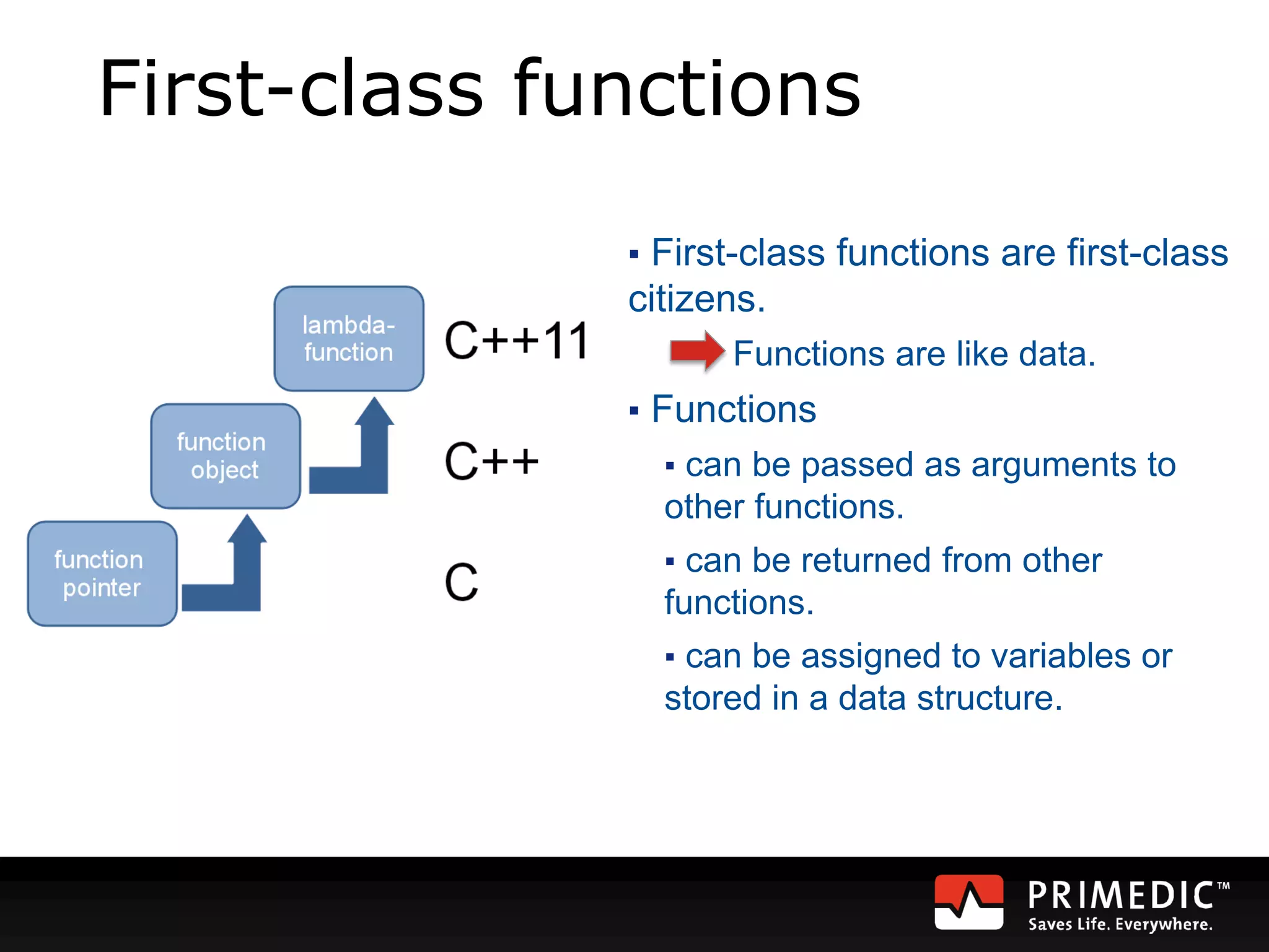
{return a + b;}));
tab.insert(std::make_pair('-',[](double a,double b){return a - b;}));
tab.insert(std::make_pair('*',[](double a,double b){return a * b;}));
tab.insert(std::make_pair('/',[](double a,double b){return a / b;}));
cout << "3.5+4.5= " << tab['+'](3.5,4.5) << endl; 8
cout << "3.5*4.5= " << tab['*'](3.5,4.5) << endl; 15.75
tab.insert(std::make_pair('^',
[](double a,double b){return std::pow(a,b);}));
cout << "3.5^4.5= " << tab['^'](3.5,4.5) << endl; 280.741](https://image.slidesharecdn.com/functionalprogramminginc-141117051806-conversion-gate01/75/Rainer-Grimm-Functional-Programming-in-C-11-9-2048.jpg)
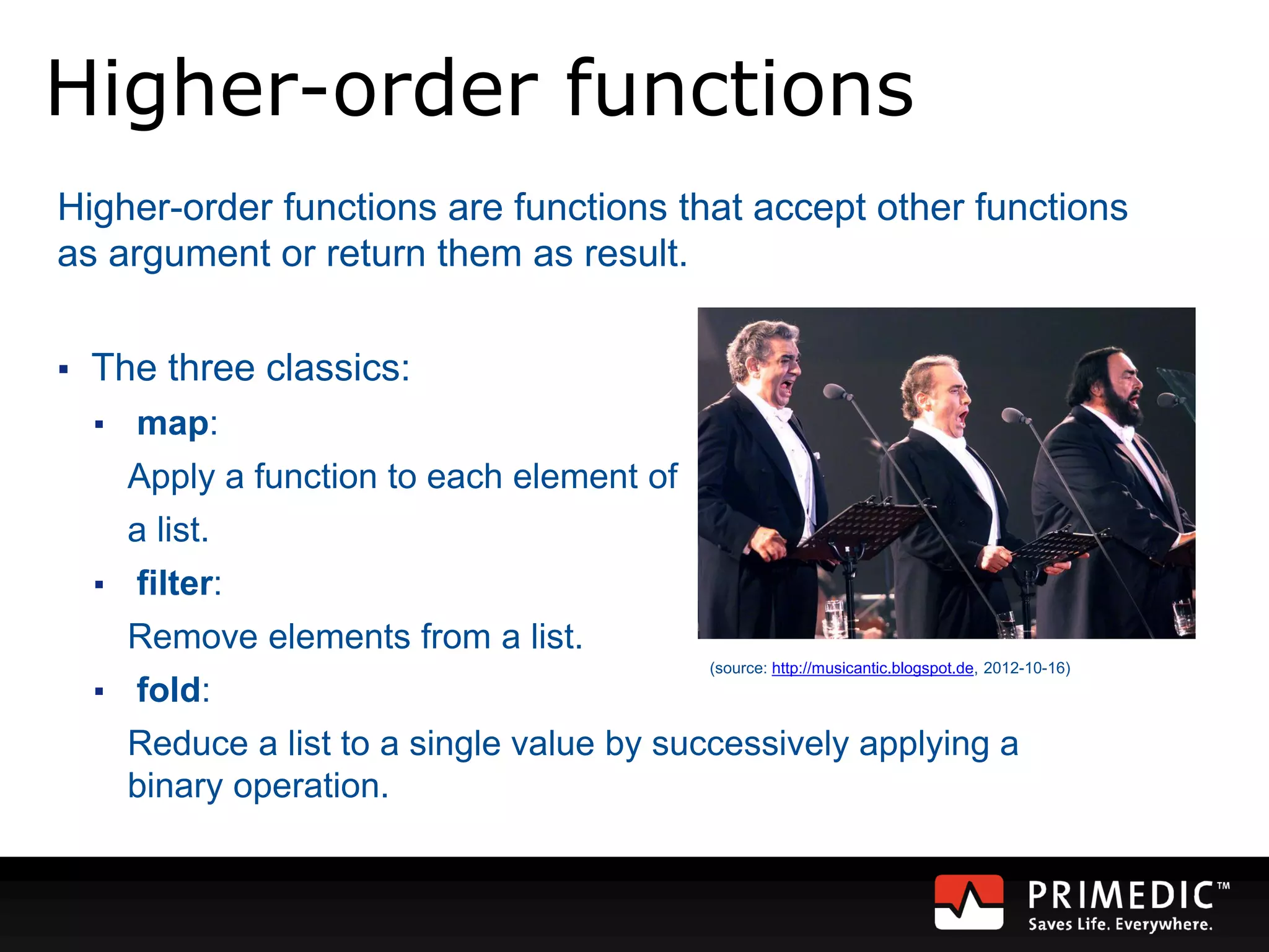
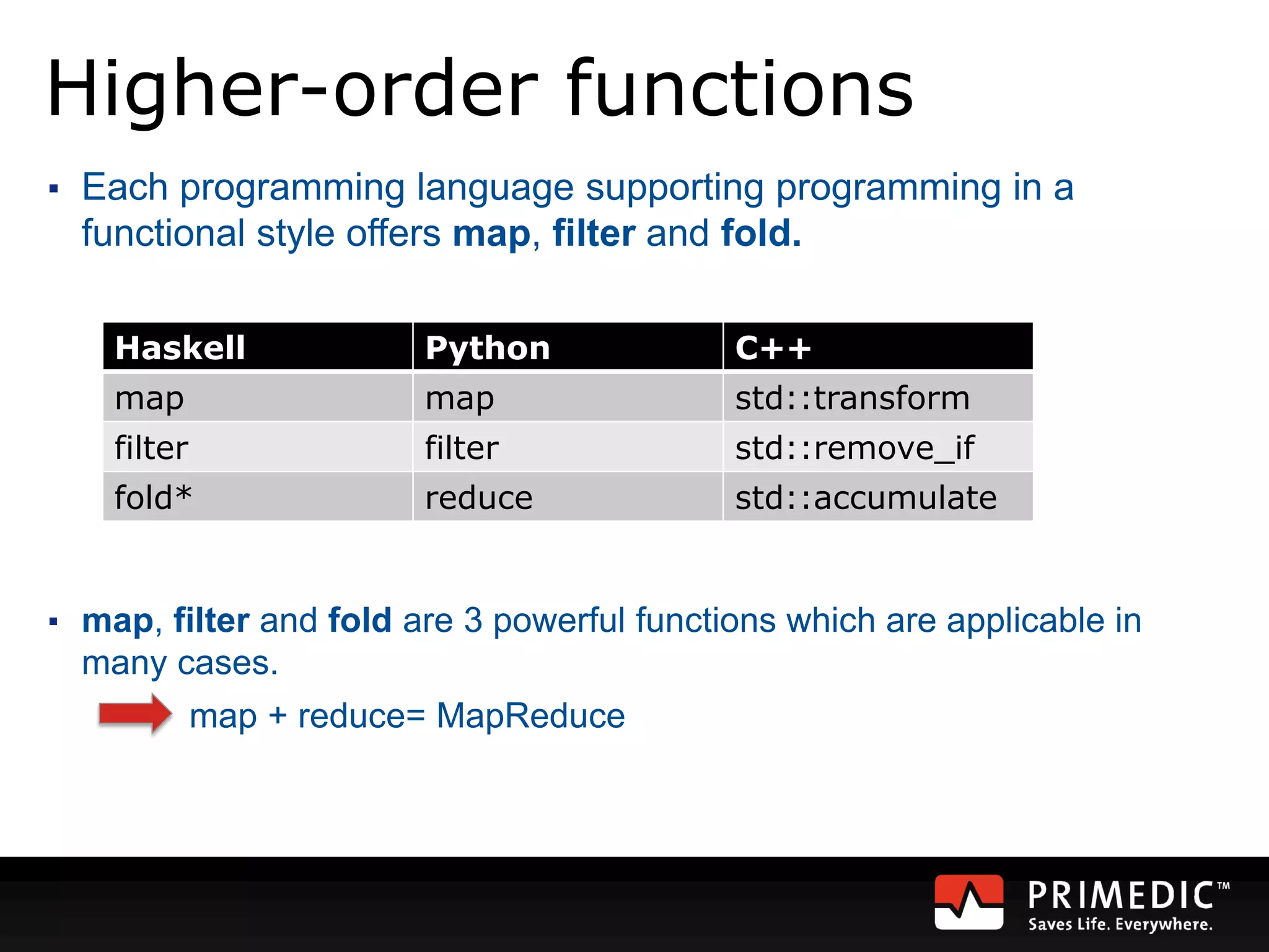
![Higher-order functions
▪ Lists and vectors:
▪ Haskell
vec= [1 . . 9]
str= ["Programming","in","a","functional","style."]
▪ Python
vec=range(1,10)
str=["Programming","in","a","functional","style."]
▪ C++
std::vector<int> vec{1,2,3,4,5,6,7,8,9}
std::vector<string>str{"Programming","in","a","functional",
"style."}
The results will be displayed in Haskell or Python notation.](https://image.slidesharecdn.com/functionalprogramminginc-141117051806-conversion-gate01/75/Rainer-Grimm-Functional-Programming-in-C-11-12-2048.jpg)
{ return i*i; });
std::transform(str.begin(),str.end(),back_inserter(vec2),
" "[](std::string s){ return s.length(); });
[1,4,9,16,25,36,49,64,81]
[11,2,1,10,6]](https://image.slidesharecdn.com/functionalprogramminginc-141117051806-conversion-gate01/75/Rainer-Grimm-Functional-Programming-in-C-11-13-2048.jpg)
![Higher-order functions: filter
▪ Haskell
filter(x-> x<3 || x>8) vec
filter(x → isUpper(head x)) str
▪ Python
filter(lambda x: x<3 or x>8 , vec)
filter(lambda x: x[0].isupper(),str)
▪ C++
auto it= std::remove_if(vec.begin(),vec.end(),
[](int i){ return !((i < 3) or (i > 8)) });
auto it2= std::remove_if(str.begin(),str.end(),
" "[](string s){ return !(isupper(s[0])); });
[1,2,9]
[“Programming”]](https://image.slidesharecdn.com/functionalprogramminginc-141117051806-conversion-gate01/75/Rainer-Grimm-Functional-Programming-in-C-11-14-2048.jpg)
{ return a*b; });
std::accumulate(str.begin(),str.end(),string(""),
" "[](string a,string b){ return a+":"+b; });
362800
“:Programming:in:a:functional:style.”](https://image.slidesharecdn.com/functionalprogramminginc-141117051806-conversion-gate01/75/Rainer-Grimm-Functional-Programming-in-C-11-15-2048.jpg)
{return a*b;});
1 * { 1 , 2 , 3 , 4 }
1 * 1
=
1 * 2
=
2 * 3
=
6 * 4 = 24](https://image.slidesharecdn.com/functionalprogramminginc-141117051806-conversion-gate01/75/Rainer-Grimm-Functional-Programming-in-C-11-16-2048.jpg)
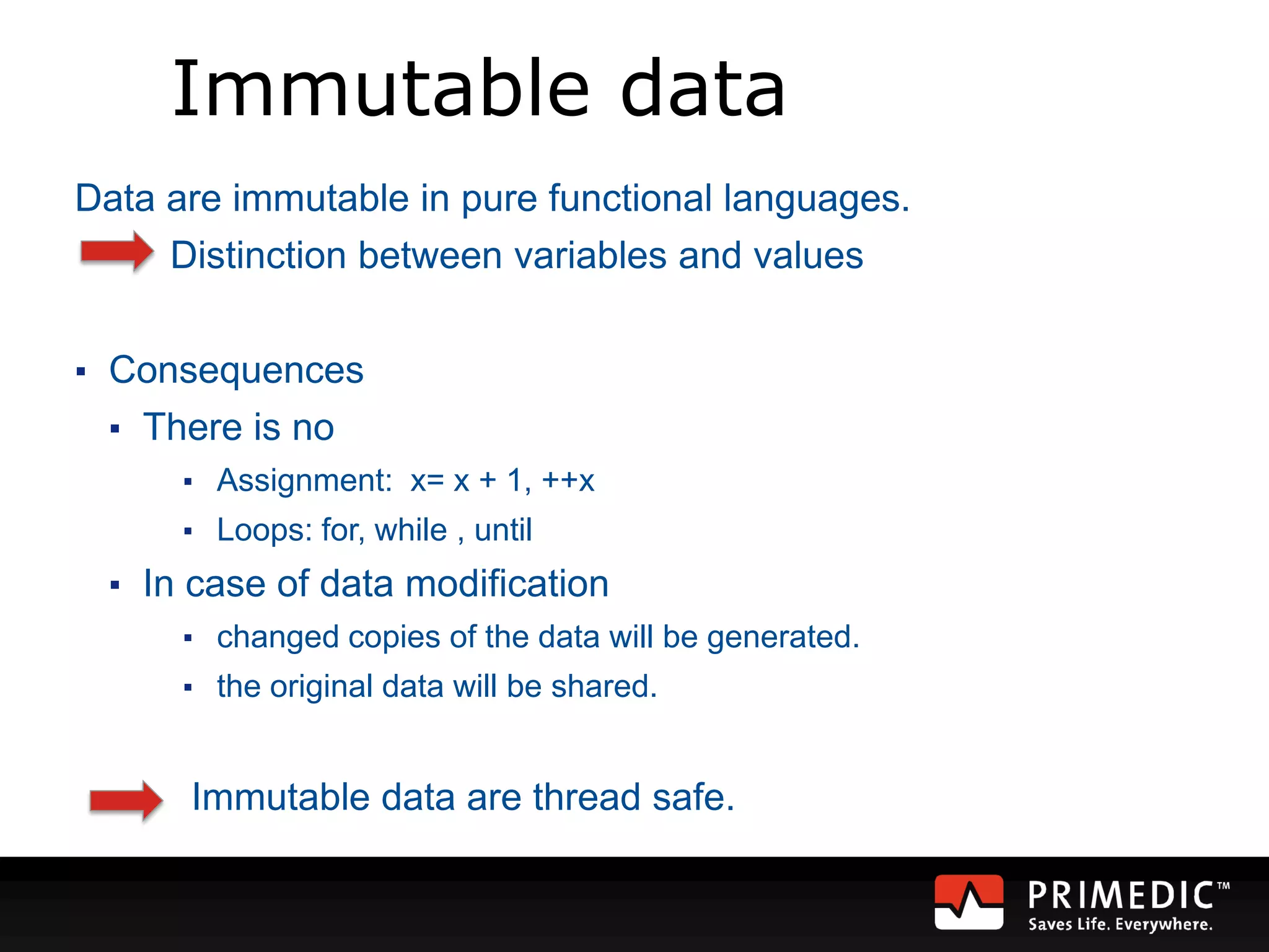
![Immutable data
• Haskell
qsort [] = []
qsort (x:xs) = qsort [y | y <- xs, y < x] ++ [x] ++ qsort [y | y <- xs, y >= x]
• C++
void quickSort(int arr[], int left, int right) {
int i = left, j = right;
int tmp;
int pivot = arr[abs((left + right) / 2)];
while (i <= j) {
while (arr[i] < pivot) i++;
while (arr[j] > pivot) j--;
if (i <= j) {
tmp = arr[i];
arr[i] = arr[j];
arr[j] = tmp;
i++; j--;
}
}
if (left < j) quickSort(arr,left,j);
if (i < right) quickSort(arr,i,right);
}](https://image.slidesharecdn.com/functionalprogramminginc-141117051806-conversion-gate01/75/Rainer-Grimm-Functional-Programming-in-C-11-18-2048.jpg)
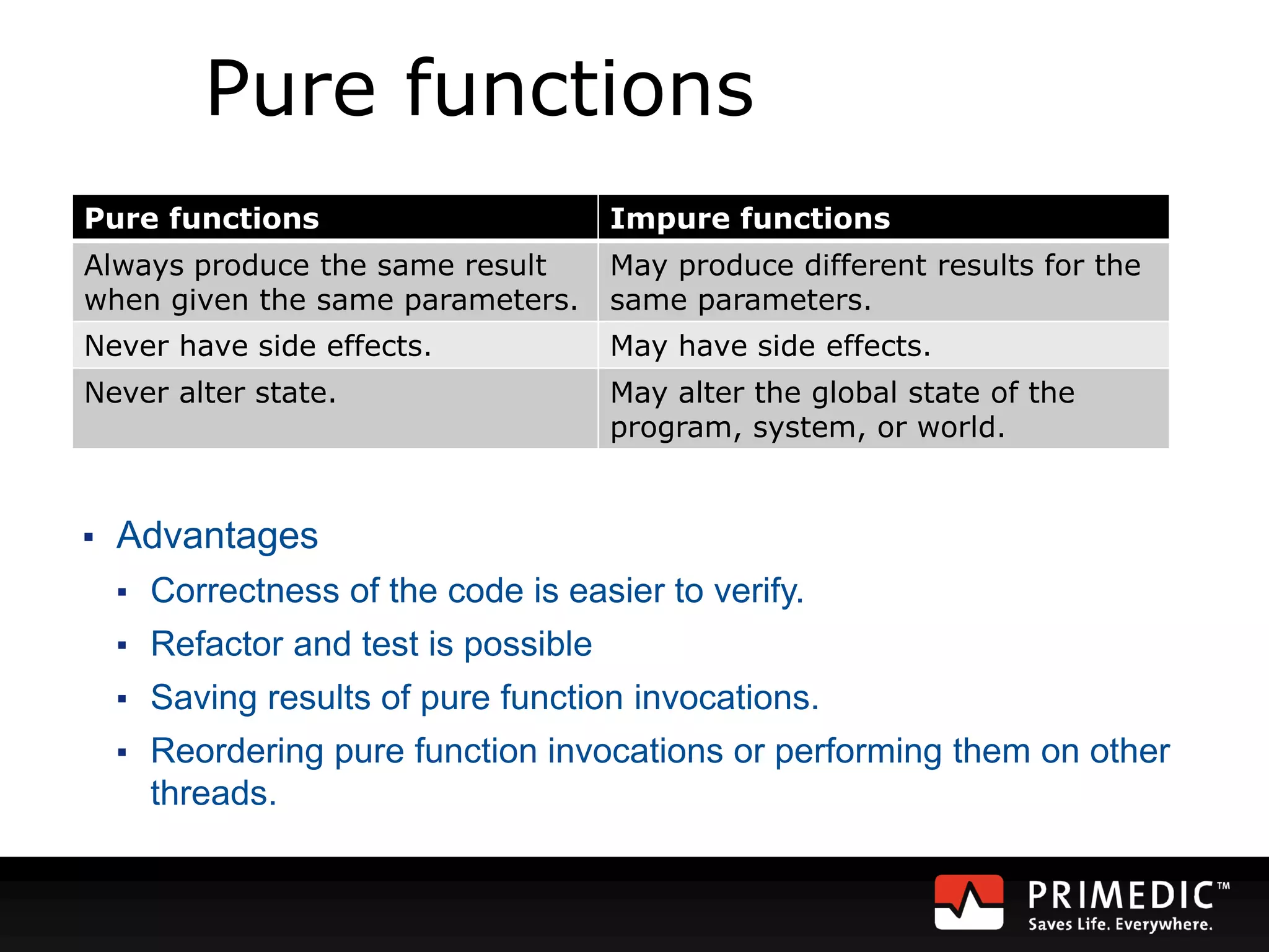
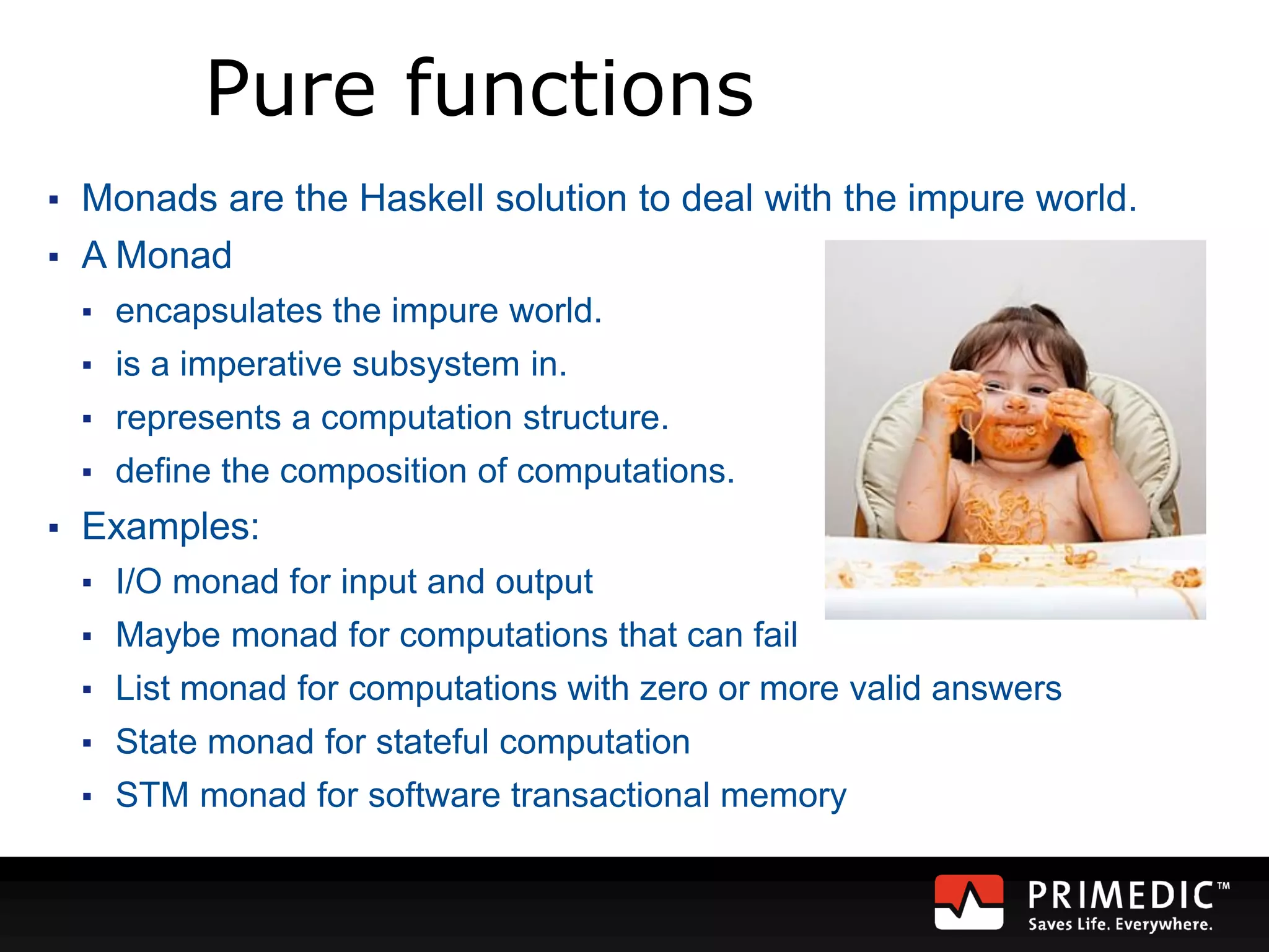
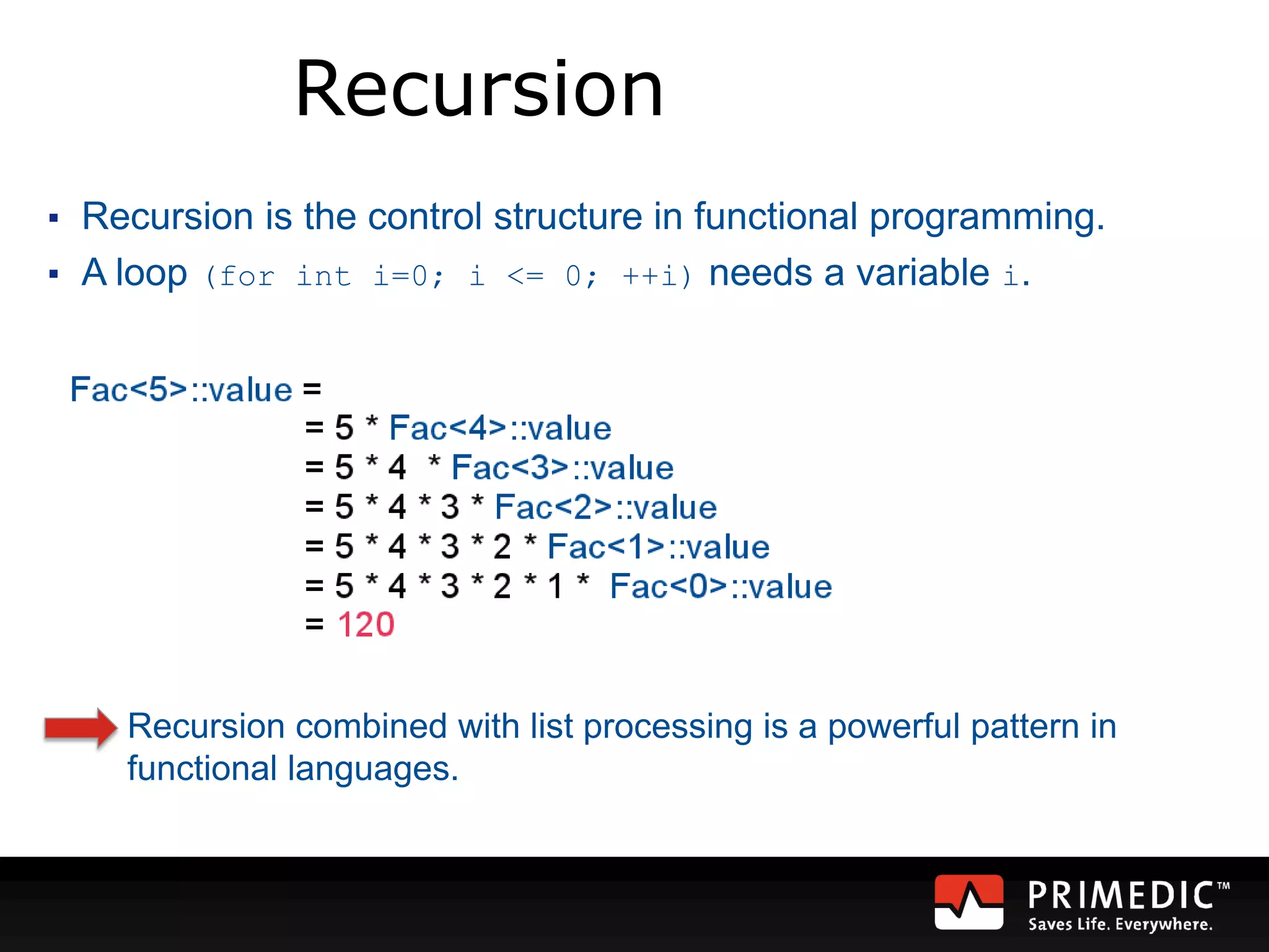
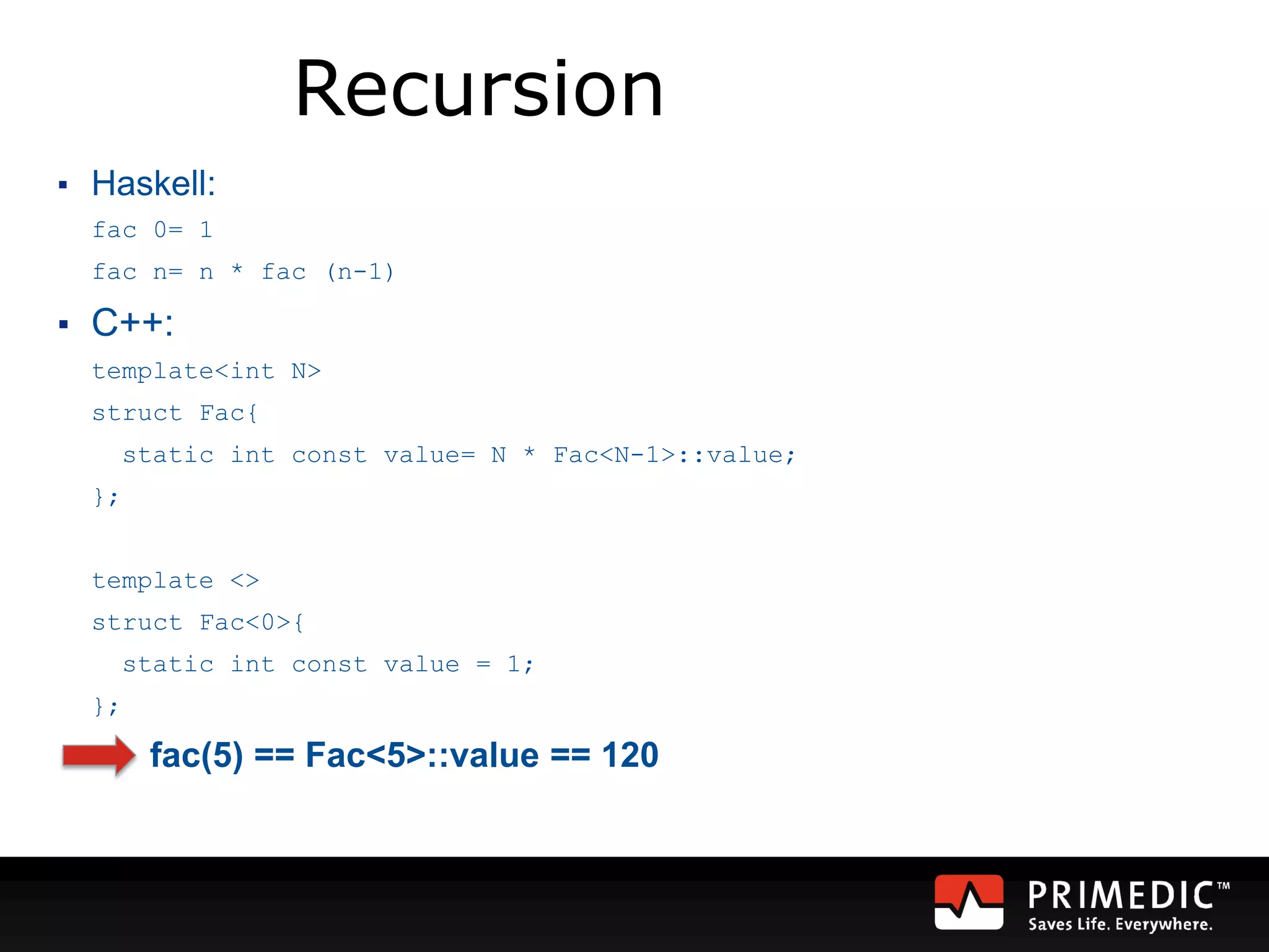
![List processing
▪ LISt Processing is the characteristic for functional programming:
▪ transforming a list into another list
▪ reducing a list to a value
▪ The functional pattern for list processing:
1. Processing the head (x) of the list
2. Recursively processing the tail (xs) of the list => Go to step 1).
mySum [] = 0
mySum (x:xs) = x + mySum xs
mySum [1,2,3,4,5] 15
myMap f [] = []
myMap f (x:xs)= f x: myMap f xs
myMap (x → x*x)[1,2,3] [1,4,9]](https://image.slidesharecdn.com/functionalprogramminginc-141117051806-conversion-gate01/75/Rainer-Grimm-Functional-Programming-in-C-11-23-2048.jpg)
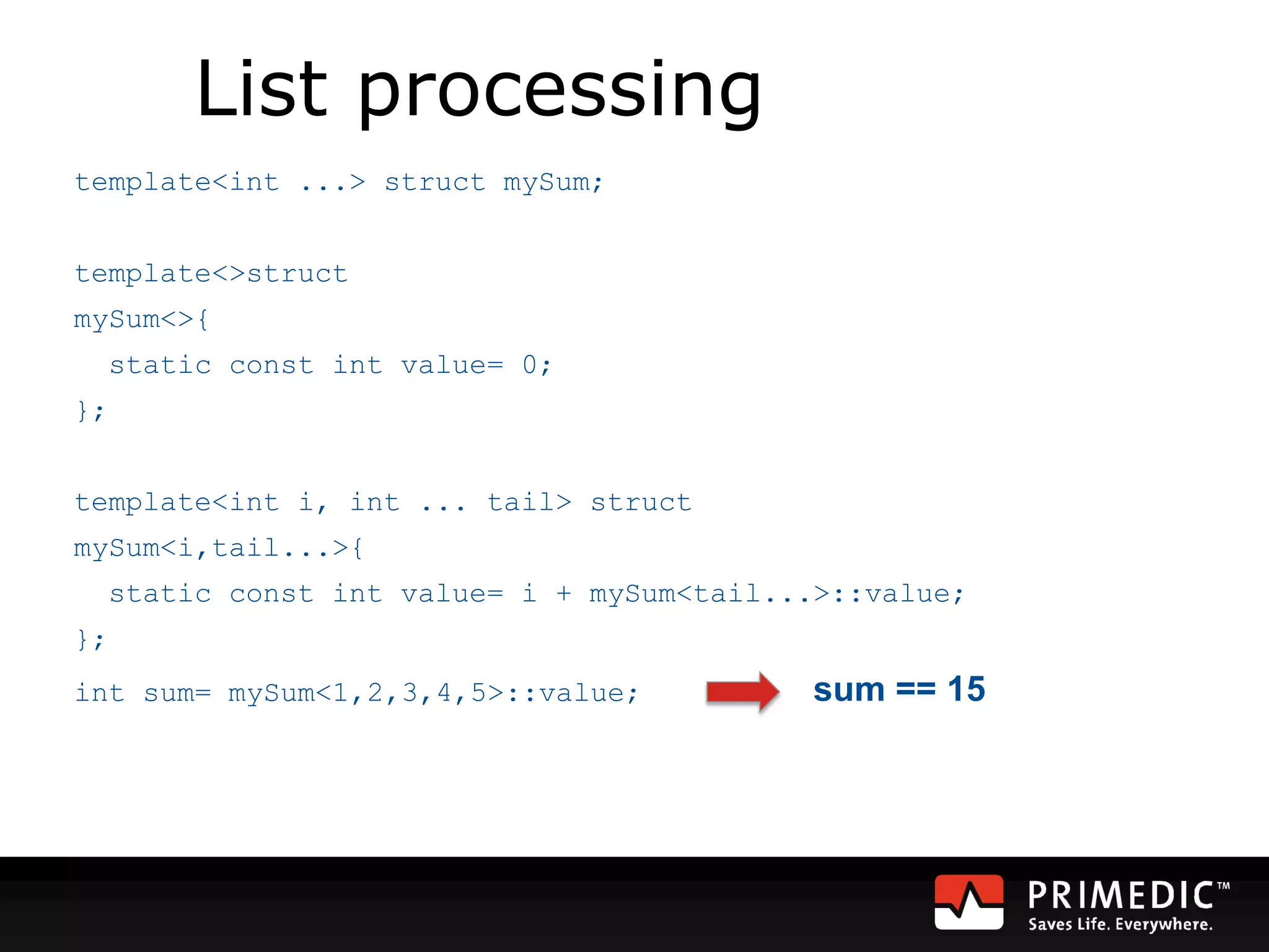
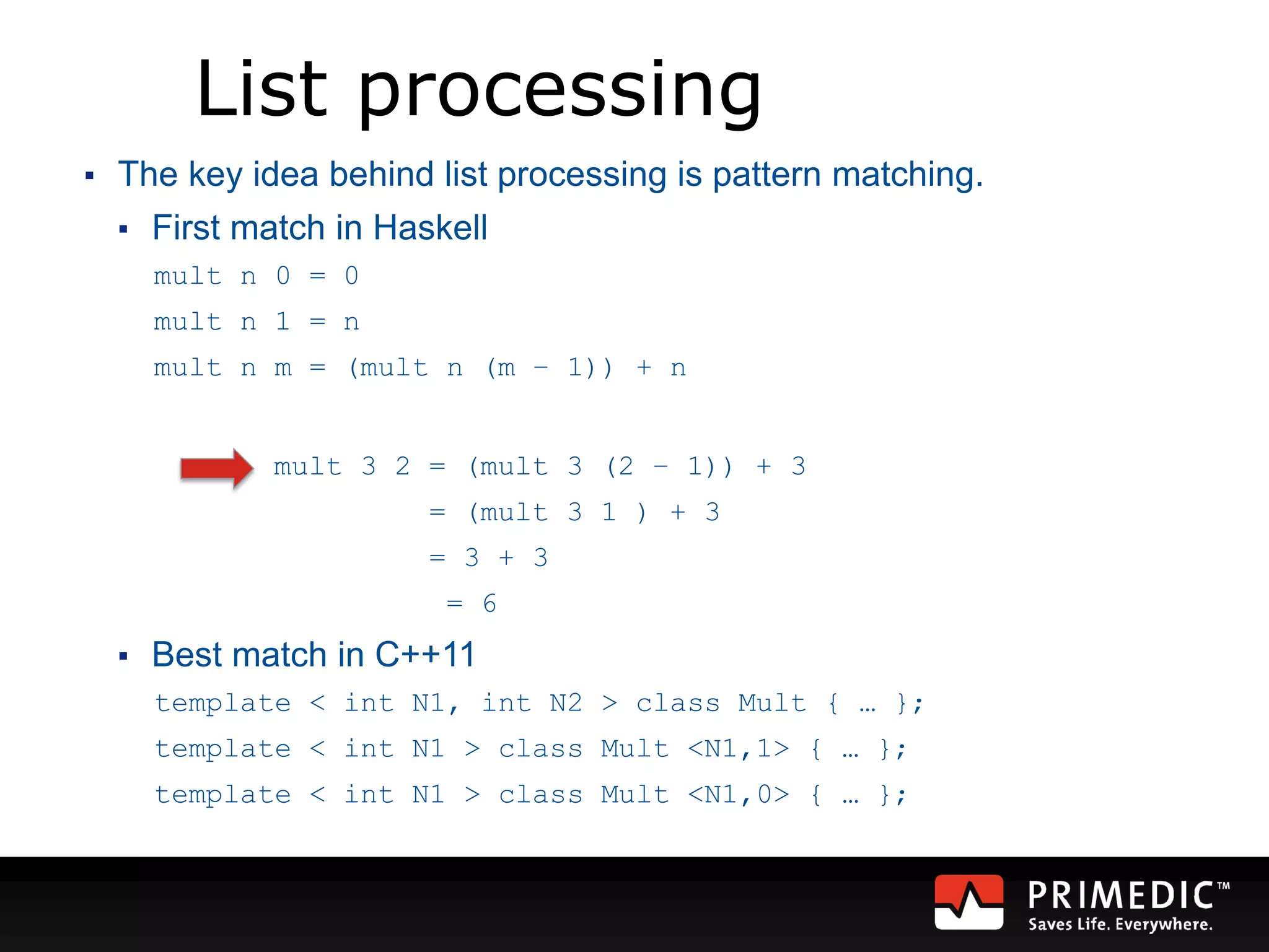
![Lazy Evaluation
▪ Evaluate only, if necessary.
▪ Haskell is lazy
length [2+1, 3*2, 1/0, 5-4]
▪ C++ is eager
int onlyFirst(int a, int){ return a; }
onlyFirst(1,1/0);
▪ Advantages:
▪ Saving time and memory usage
▪ Working with infinite data structures](https://image.slidesharecdn.com/functionalprogramminginc-141117051806-conversion-gate01/75/Rainer-Grimm-Functional-Programming-in-C-11-26-2048.jpg)
![Lazy Evaluation
▪ Haskell
successor i= i: (successor (i+1))
take 5 ( successor 10 ) [10,11,12,13,14]
odds= takeWhile (< 1000) . filter odd . map (^2)
[1..]= [1,2,3,4,5,6,7,8,9,10,11,12,13,14,15 ... Control-C
odds [1..] [1,9,25, … , 841,961]
▪ Special case in C++: short circuit evaluation
if ( true or (1/0) ) std::cout << "short circuit evaluation in C++n";](https://image.slidesharecdn.com/functionalprogramminginc-141117051806-conversion-gate01/75/Rainer-Grimm-Functional-Programming-in-C-11-27-2048.jpg)
![What's missing?
▪ List comprehension: Syntactic sugar for map and filter
▪ Like mathematic
{ n*n | n e N , n mod 2 = 0 } : Mathematik
[n*n | n <- [1..], n `mod` 2 == 0 ] : Haskell
▪ Python
[n for n in range(8)] [0,1,2,3,4,5,6,7]
[n*n for n in range(8)] [0,1,4,9,16,25,36,49]
[n*n for n in range(8) if n%2 == 0] [0,4,16,36]](https://image.slidesharecdn.com/functionalprogramminginc-141117051806-conversion-gate01/75/Rainer-Grimm-Functional-Programming-in-C-11-28-2048.jpg)
![What's missing?
Function composition: fluent interface
▪ Haskell
(reverse . sort)[10,2,8,1,9,5,3,6,4,7]
[10,9,8,7,6,5,4,3,2,1]
isTit (x:xs)= isUpper x && all isLower xs
sorTitLen= sortBy(comparing length).filter isTit . words
sorTitLen “A Sentence full of Titles .“
[“A“,“Titles“,“Sentence“]](https://image.slidesharecdn.com/functionalprogramminginc-141117051806-conversion-gate01/75/Rainer-Grimm-Functional-Programming-in-C-11-29-2048.jpg)
